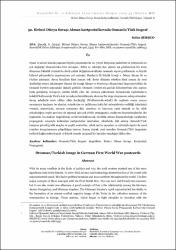52. Birinci Dünya Savaşı Alman kartpostallarında Osmanlı/Türk imgesi
Citation
Şimşek, S. (2023). Birinci Dünya Savaşı Alman kartpostallarında Osmanlı/Türk imgesi. RumeliDE Dil ve Edebiyat Araştırmaları Dergisi, (33), 877-889. https://doi.org/10.29000/rumelide.1286033Abstract
Siyasi ve askeri alanda yaşanan büyük çatışmaları ile 20. yüzyıl dünyanın kaderinin ve çehresinin en
çok değiştiği dönemlerden biri olmuştur. Bilim ve tekniğin her alanda eşi görülmemiş bir hızla
dünyanın bilindik yüzünü bu denli çabuk değiştirmesi ülkeler arasında siyasi gerilimlerin ve büyük
kitlesel çekişmelerin yaşanmasına yol açmıştır. Bunların ilk büyük örneği 1. Dünya Savaşı ile su
yüzüne çıkmıştır. Savaş koşulları kimi zaman eski dostu düşman ederken kimi zaman da yeni
dostluklar ortaya çıkarmıştır. Bunun bir örneği Alman ve Avusturya-Macaristan İmparatorlukları ile
Osmanlı Devleti arasındaki ilişkide görülür. Osmanlı Devleti’nin parlak dönemlerinde etki alanını
hızla genişletip Avrupa’yı sürekli tehdit eder bir noktaya yükselmesi Avrupa’daki toplulukların
kolektif hafızasında Türk’e dair neredeyse kemikleşmiş olumsuz bir imge oluşmasına sebep olmuştur.
Savaş sebebiyle tesis edilen silah kardeşliği (Waffenbruderschaft) ile cephede omuz omuza
savaşmaya başlayan bu uluslar, askerlerine ve halklarına haklı bir mücadelenin verildiği izlenimini
vermek, maneviyatı, savaşın sonucuna dair umutları ve heyecanı canlı tutmak ve bu silah
arkadaşlığını cephe gerisine de taşımak için çok yönlü propaganda araçlarına başvurmuşlardır. Bu
bağlamda, bu makale imgebilimin verilerini kullanarak, özellikle Alman İmparatorluğu tarafından
propaganda amacıyla kullanılan kartpostallar üzerinden, zihinlerde kök salmış Osmanlı/Türk
imajının görsel/grafik araçlar ve çeşitli semboller, edebi metin parçaları ve mitolojik ögeler ile nasıl
yeniden kurgulanmaya çalışıldığını inceler. Sonuç olarak, yeni sunulan Osmanlı/Türk imgesinin
tarihsel bağlarından kopuk ve büyük oranda kurgusal bir karakter taşıdığını iddia eder. With its many conflicts in the fields of politics and war, the 20th century marked one of the most
significant eras in the history. In every field, science and technology altered the face of the world with
unprecedented speed. This led to political tensions and mass conflicts throughout the world. The first
major example of these emerged with the First World War. War can turn old friends into enemies,
but it can also create new alliances. A good example of this is the relationship among the German,
Austro-Hungarian, and Ottoman empires. The Ottoman Empire's rapid expansion led inevitably to
the formation of an almost ossified negative image of the Turks in the collective memory of the
communities in Europe. These nations, which began to fight shoulder to shoulder with the brotherhood of arms, resorted to a variety of propaganda tools to give their soldiers and people the
impression that a just struggle was being waged, to keep the morale, hopes, and excitement high
about the outcome of the war, and to carry this brotherhood behind the front lines. In this context,
this article uses the data of imagology to examine how the Ottoman/Turkish image, which had taken
root in minds, was reconstructed through visual/graphic tools and various symbols, literary text
fragments and mythological elements, especially through the postcards used by the German Empire
for propaganda purposes. As a result, it argues that the newly presented Ottoman/Turkish image is
detached from its historical ties and has a largely fictional character.


















